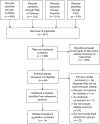Housing Assistance and Child Health: A Systematic Review
- PMID: 29765008
- PMCID: PMC6662196
- DOI: 10.1542/peds.2017-2742
Housing Assistance and Child Health: A Systematic Review
Abstract
Context: Given a large and consistent literature revealing a link between housing and health, publicly supported housing assistance programs might play an important role in promoting the health of disadvantaged children.
Objective: To summarize and evaluate research in which authors examine housing assistance and child health.
Data sources: PubMed, Web of Science, PsycInfo, and PAIS (1990-2017).
Study selection: Eligible studies were required to contain assessments of public housing, multifamily housing, or vouchers in relation to a health outcome in children (ages 0-21); we excluded neighborhood mobility interventions.
Data extraction: Study design, sample size, age, location, health outcomes, measurement, program comparisons, analytic approach, covariates, and results.
Results: We identified 14 studies, including 4 quasi-experimental studies, in which authors examined a range of health outcomes. Across studies, the relationship between housing assistance and child health remains unclear, with ∼40% of examined outcomes revealing no association between housing assistance and health. A sizable proportion of observed relationships within the quasi-experimental and association studies were in favor of housing assistance (50.0% and 37.5%, respectively), and negative outcomes were less common and only present among association studies.
Limitations: Potential publication bias, majority of studies were cross-sectional, and substantial variation in outcomes, measurement quality, and methods to address confounding.
Conclusions: The results underscore a need for rigorous studies in which authors evaluate specific housing assistance programs in relation to child outcomes to establish what types of housing assistance, if any, serve as an effective strategy to reduce disparities and advance equity across the lifespan.
Copyright © 2018 by the American Academy of Pediatrics.
Conflict of interest statement
POTENTIAL CONFLICT OF INTEREST: The authors have indicated they have no potential conflicts of interest to disclose.
Figures
Similar articles
-
Recovery schools for improving behavioral and academic outcomes among students in recovery from substance use disorders: a systematic review.Campbell Syst Rev. 2018 Oct 4;14(1):1-86. doi: 10.4073/csr.2018.9. eCollection 2018. Campbell Syst Rev. 2018. PMID: 37131375 Free PMC article.
-
Association of Childhood Asthma With Federal Rental Assistance.JAMA Pediatr. 2020 Jun 1;174(6):592-598. doi: 10.1001/jamapediatrics.2019.6242. JAMA Pediatr. 2020. PMID: 32150240 Free PMC article.
-
Housing Assistance Programs and Adult Health in the United States.Am J Public Health. 2017 Apr;107(4):571-578. doi: 10.2105/AJPH.2016.303649. Epub 2017 Feb 16. Am J Public Health. 2017. PMID: 28207335 Free PMC article.
-
Effects of guaranteed basic income interventions on poverty-related outcomes in high-income countries: A systematic review and meta-analysis.Campbell Syst Rev. 2024 Jun 16;20(2):e1414. doi: 10.1002/cl2.1414. eCollection 2024 Jun. Campbell Syst Rev. 2024. PMID: 38887375 Free PMC article. Review.
-
Impact of summer programmes on the outcomes of disadvantaged or 'at risk' young people: A systematic review.Campbell Syst Rev. 2024 Jun 13;20(2):e1406. doi: 10.1002/cl2.1406. eCollection 2024 Jun. Campbell Syst Rev. 2024. PMID: 38873396 Free PMC article. Review.
Cited by
-
Policy solutions to eliminate racial and ethnic child health disparities in the USA.Lancet Child Adolesc Health. 2024 Feb;8(2):159-174. doi: 10.1016/S2352-4642(23)00262-6. Lancet Child Adolesc Health. 2024. PMID: 38242598 Free PMC article. Review.
-
Child Poverty and Health: The Role of Income Support Policies.Milbank Q. 2023 Apr;101(S1):379-395. doi: 10.1111/1468-0009.12623. Milbank Q. 2023. PMID: 37096615 Free PMC article. Review.
-
Indicators of Neighborhood-Level Socioeconomic Position and Pediatric Critical Illness.Chest. 2023 Dec;164(6):1434-1443. doi: 10.1016/j.chest.2023.07.014. Epub 2023 Jul 23. Chest. 2023. PMID: 37487988 Free PMC article.
-
Association Between Rental Assistance Programs and Hemoglobin A1c Levels Among US Adults.JAMA Netw Open. 2022 Jul 1;5(7):e2222385. doi: 10.1001/jamanetworkopen.2022.22385. JAMA Netw Open. 2022. PMID: 35857325 Free PMC article.
-
Associations between local government expenditures and low birth weight incidence: Evidence from national birth records.Prev Med Rep. 2019 Aug 30;16:100985. doi: 10.1016/j.pmedr.2019.100985. eCollection 2019 Dec. Prev Med Rep. 2019. PMID: 31516818 Free PMC article.
References
-
- National Academies of Sciences and Medicine. A Framework for Educating Health Professionals to Address the Social Determinants of Health. Washington, DC: National Academies Press; 2016 - PubMed
-
- Woolf SH, Braveman P. Where health disparities begin: the role of social and economic determinants–and why current policies may make matters worse. Health Aff(Millwood). 2011;30(10):1852–1859 - PubMed
-
- Garner AS, Shonkoff JP; Committee on Psychosocial Aspects of Child and Family Health; Committee on Early Childhood, Adoption, and Dependent Care; Section on Developmental and Behavioral Pediatrics. Early childhood adversity, toxic stress, and the role of the pediatrician: translating developmental science into lifelong health. Pediatrics. 2012;129(1). Available at: www.pediatrics.org/cgi/content/full/129/1/e224 - PubMed
-
- Council on Community Pediatrics. Poverty and child health in the United States. Pediatrics. 2016;137(4):e20160339 - PubMed
-
- Shaw M. Housing and public health. Annu Rev Public Health. 2004;25:397–418 - PubMed
Publication types
MeSH terms
Grants and funding
LinkOut - more resources
Full Text Sources
Other Literature Sources
Medical


